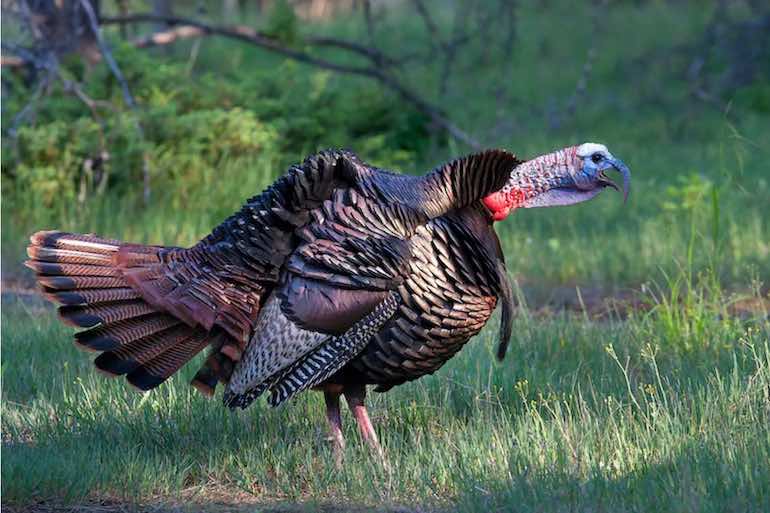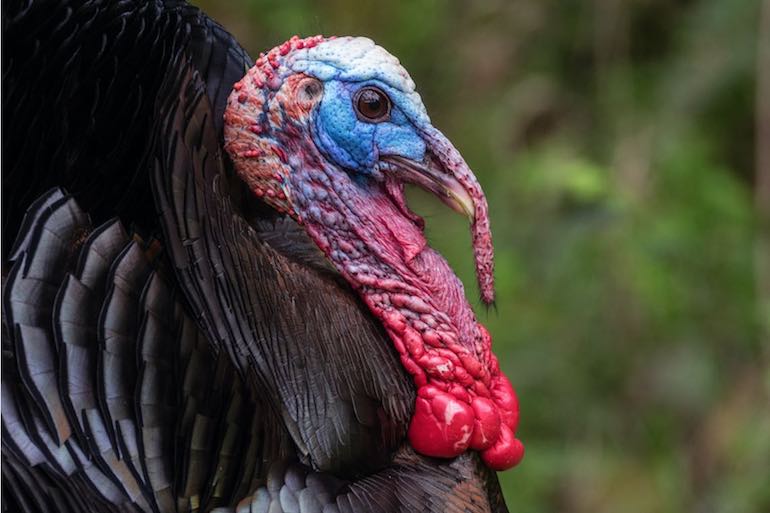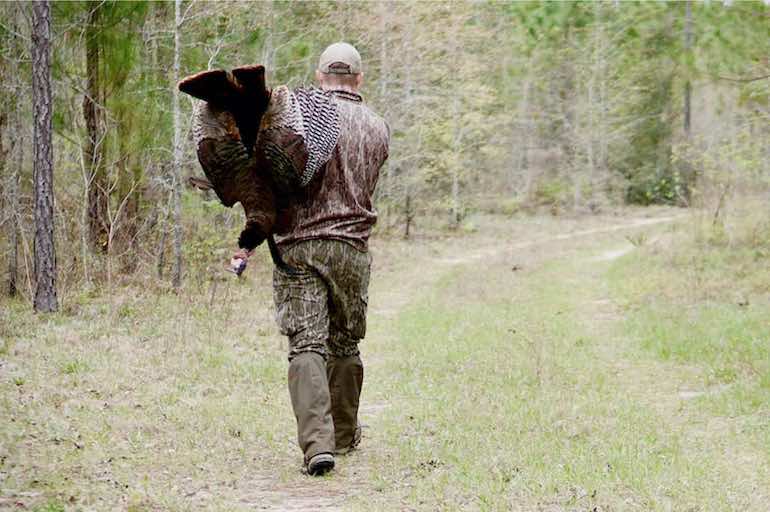What Happens When a Turkeys Head Turns Blue
How to Read a Turkey's Body Language
Getting to know a turkey's body language better can truly help you this hunting season.

Eastern wild turkey male (Meleagris gallopavo) in full strutting display gobbling through a grassy meadow. (Shutterstock image)
February 17, 2021
Turkey hunting has long been an obsession of mine. I like to credit Meleagris gallopavo with providing me with some of the most fun and frustration of any game animal in North America. These wily birds can see and hear well, and possess a supernatural sense that has been baffling predators for hundreds of year.
I have several stories where an old tom was coming in; he was at 40 yards, 35 yards, he steps behind a tree on the other side of which I'm planning on taking him, but he never steps out. I never see or hear from him again; he just disappears. Turkeys can do things that most wild game don't, or won't.
It seems almost unreal that when a gobbler seems to be maintaining a path to the business end of a shotgun, he is seeing and hearing almost everything, including the camouflaged predator who swings a shotgun a little early as the bird disappears behind a tree.
- Check out the video below on Rio Grande turkey hunting with Browning and Game & Fish editor Dr. Todd Kuhn.
However, observant hunters can obtain insight to what is about to happen by truly paying attention to the bird.
Many hunters try and read a turkey's body language as an indicator of state of mind and whether the bird is coming to the call or about to hightail it the other way. They are big birds that sound like Mac trucks taking off when they get ready to fly, but don't let that fool you for a second.
A grown turkey hen or gobbler can light a shuck and be in the next county while you're still wondering what just happened.
Getting to know their body language just a little better can truly help you this spring.
THE STRUT
Let's start with something that seems rather simple. Most hunters know what the strut means, right? He's hot, he's looking and if it happens to be your calls that have enticed him, then here he comes. But what about the times when a bowed-up gobbler seems to be heading right into the decoy only to stop and spin around 80 yards out?
When this happens, hunters need to not get impatient, discouraged or, especially, let down their guard. The gobbler has probably been around for a few springs and is exuding ultimate caution by trying to get the hen to unhinge herself from the earth and come out to him.
Recommended
"At this critical juncture, I quit calling," said Brandon Jones, federal game warden, wildlife biologist and lead project manager at Nebraska's Rainwater Basin Wetland Management District. "He's telling you loud and clear that he's not sure what to do next. If you continue to call, he'll likely think you're overly interested and wait for you to come out."
So, in the name of love, shut up and let him make the next move.

DISCOLORATION
Looking at a gobbler's head is about the best way to tell how he's feeling. A relaxed tom usually maintains white, light blue and red shades while one that is worked up will have a head full of blood that will be dark red. Pay special attention when he is in strut and you'll notice how white his head is.
If at anytime that bird appears as though he's coming in on a string, but suddenly stops, lifts his head up and comes out of full strut, his head will start turning red with worry. He's seen movement or something just doesn't feel right about his current situation. Remember how turkeys have that odd sense that makes them seem telepathic?
In this predicament, a gobbler has stopped outside of shotgun range and is looking intently at his surroundings, hunters often try one of two tactics, neither of which is ideal. They either try for a long shot, which can wound but not kill the turkey, or they wait until the bird isn't looking and try to jump up in an attempt to subtract a few yards before firing. It's best to save the heartache for another day.
"It's a bad feeling when a gobbler that you've been working suddenly stops and folds or pops his wings," said Dr. Jim Casada, author of several books on turkey hunting, including the acclaimed "Remembering the Greats: Profiles of Turkey Hunting's Old Masters." "He's seen enough and is getting ready to head to a new ZIP code."
If he's performed the same movements within the boundaries of a shotgun's range, then shoot, as this bird is becoming increasingly nervous as the seconds tick away and is very likely about to avoid the deep fryer.

STUDY THE SNOOD
Funny word, "snood," and the item that carries the name is just about as funny. However, the snood is a great indicator of a gobbler's mood, as this fleshy protuberance hanging from the head of a gobbler contracts and expands depending on whether he is relaxed, nervous or even starting to wonder what is going on.
When a big tom is strutting around for the ladies or hanging out feeding without a care, the snood hangs from the head, swinging with ever step and head turn. If that hanging flesh starts to contract it means he is thinking but not freaked out just yet. However, if the snood shrinks up to a small protrusion on top of the head, the gig is up and you had better fire if you have a shot.
LAY ME DOWN
Some of the most exhilarating hunts of my life involved a decoy called Fred, which is the mount of a gobbler my father killed almost two decades ago. Fred weighs about 25 pounds, and I've been using him as a decoy for the past several seasons; I've even had to save him from mauling on several occasions.
During those times of protecting Fred from a thrashing, I've also witnessed the interesting body language of hens.
During one particular hunt, I was actually doing what is now referred to as "reaping" (an altogether irrelevant term as if it's a guaranteed method). A henned-up tom was about 100 yards down a dirt road surrounded by open fields and rolling hills.
I sent Fred forth, on my knees behind his fan, holding his body up with one hand under his breast while I held my Mossberg in the other. The turkeys had gone over a hill and weren't in sight as I inched my way down the road.

Then three hens came over the hill and straight to Fred. At 3 feet, the hens laid down, side by side, facing away from Fred. Apparently, Fred had become the dominant bird and they were showing their affection.
Long story short, the "real" gobbler came over the rise, saw what was going on, and within seconds was shot at five steps. It was intense, and also something that I would have never tried on public land.
Of course, turkeys can drive you mad if you're not careful. Be patient when hunting these wily birds, and try not to get over anxious because more times than not, you're going to fail. But then again, who is to say that a beautiful spring morning - the air warming, dogwoods blooming - suggests anything about failure?
Source: https://www.gameandfishmag.com/editorial/how-to-read-a-turkeys-body-language/193075
0 Response to "What Happens When a Turkeys Head Turns Blue"
Postar um comentário